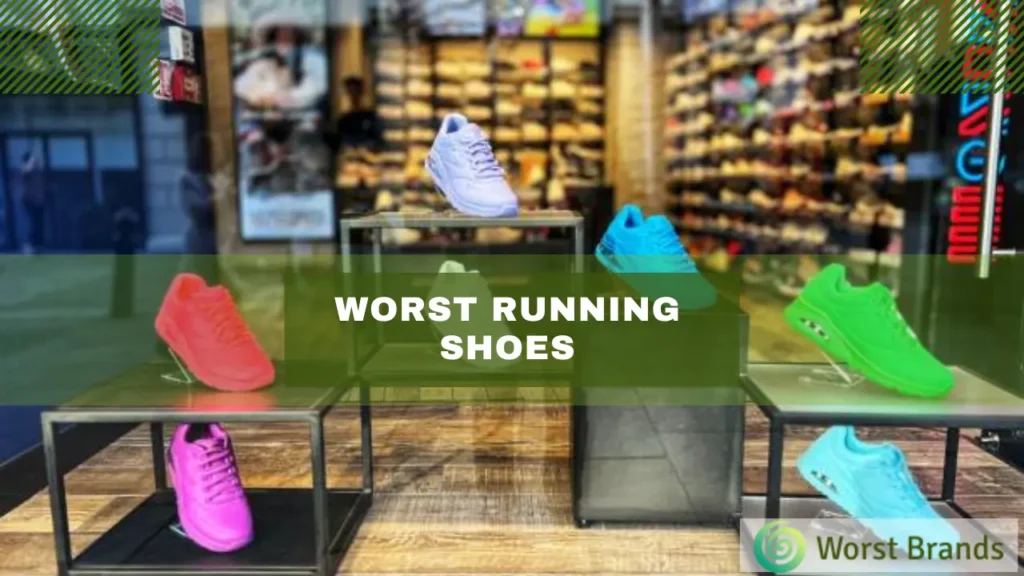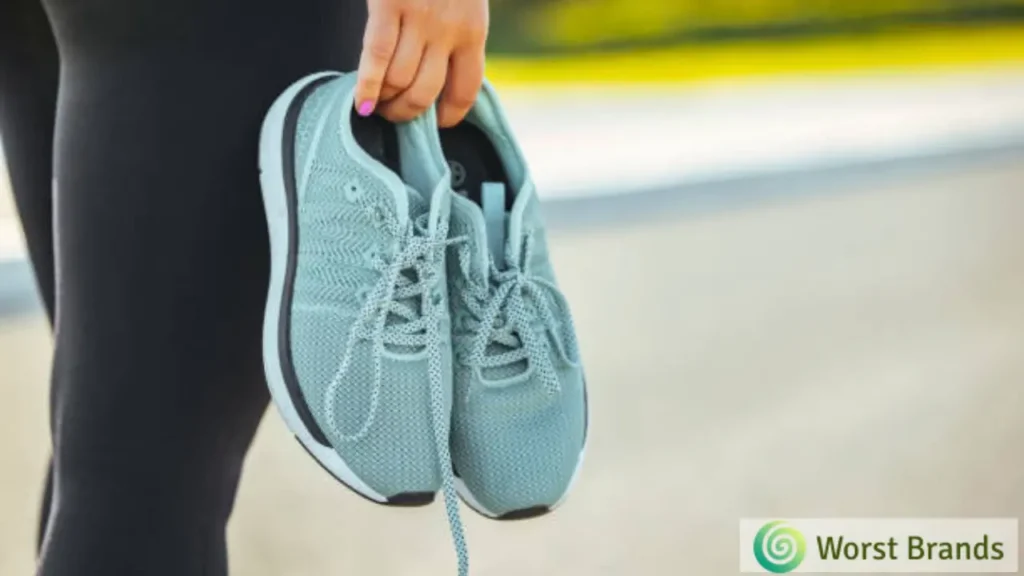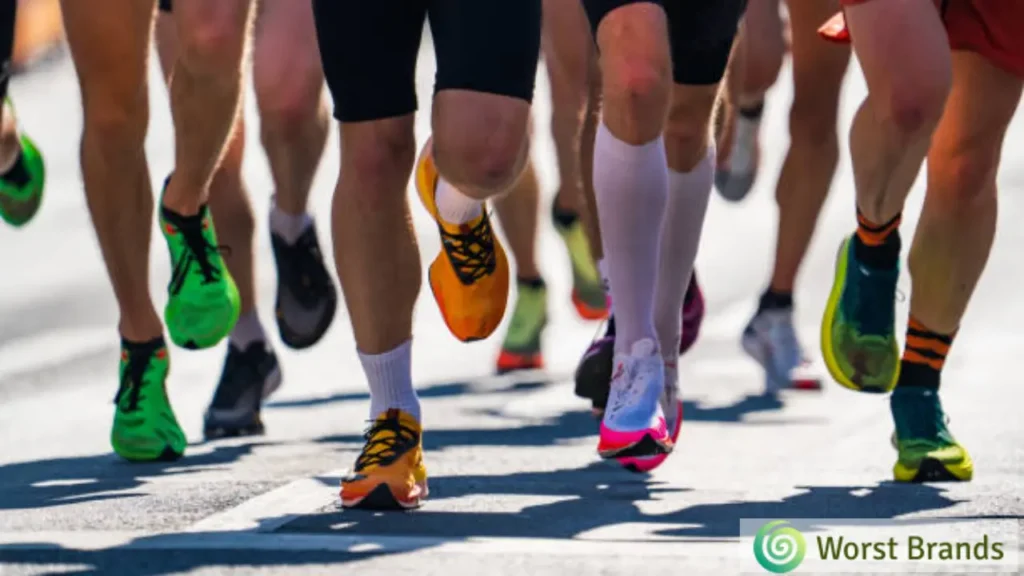
In the expansive world of athletic footwear, there are stars, and then there are duds.
While numerous brands put forth attractive claims and eye-catching designs, not all deliver on their promises.
As a result, some products are labeled as the worst running shoes.
Today, we’ll talk about these less-than-stellar options, offering insights and observations to help you make an informed decision and avoid a regrettable purchase like one should avoid the worst Adidas sneakers.
Table of Contents
- Worst Running Shoes
- 1. Kapsen Men’s Running Shoes Blade Tennis
- 2. K KIP WOK Fashion Glitter Sneakers for Women
- 3. GJUYC Running Sneakers for Men
- 4. QZHIHE Men’s Running Shoes
- 5. Merrell Men’s Trail Glove 6 Sneaker
- What Makes A Bad Running Shoes?
- Inadequate Support
- Misleading Sizing
- Compromised Durability
- Poor Breathability
- Lack of Traction
- Wrapping Up
- Christopher Evans
Worst Running Shoes
Based on comfort, longevity, and value for money, the worst running shoes for men and women are from Kapsen, K KIP WOK, GJUYC, QZHIHE, and Merrell.
1. Kapsen Men’s Running Shoes Blade Tennis
In the shoe realm, I hoped these sneakers would be like a chart-topping hit. But they were far from great. While they might look stylish, the comfort level is severely lacking.
I found them painfully unsupportive, reminiscent of walking on jagged rocks.
The thin foam lining was a far cry from the cushiony memory foam many seek in a quality running shoe.
For those constantly on the move, be wary. These aren’t the trusty companions you need on a long day.
And, a word to the wise: the design of the sole might just trip you up, both literally and figuratively.
2. K KIP WOK Fashion Glitter Sneakers for Women
Lured in by the flashy aesthetics, much like a sparkling stage for a rockstar, these sneakers had promise. However, they are among the worst running shoes for women.
Several customers have reported the sole started peeling away after just a few days. The glitter faded away with some use, too.
While their visual allure is undeniable, their structural integrity raises concerns.
A running shoe’s prime function should be support and longevity; on these fronts, these sneakers falter.

3. GJUYC Running Sneakers for Men
At the outset, the GJUYC Sneakers for Men showcased a promise of both breathability and support, two critical factors for any serious runner or athlete.
However, the practical experience diverged from these initial impressions.
Wearing them for prolonged periods proved challenging, with consistent discomfort overshadowing their sleek design.
The inner structure of the shoe seemed misaligned with the foot’s natural contours, leading to a sense of constant unease.
For those prioritizing comfort and sustained wear in their running shoes, there might be better choices than these.
4. QZHIHE Men’s Running Shoes
When you invest in a pair of running shoes, you expect a combination of comfort, durability, and support.
Based on personal experience and extensive feedback, the QZHIHE Men’s Running Shoes leave much to be desired.
The fit was the first red flag. Despite selecting my usual size, the sneakers felt oversized, causing my foot to shift inside.
This lack of snugness was problematic, especially during runs.
While initially appealing, the shoe’s lightweight nature seemed to compromise its durability. After only a few uses, wear and tear became evident.
Additionally, the shoe’s material also raised concerns. It had an off-putting odor and felt somewhat cheap, suggesting possible issues with the quality of construction.
To add to the list of grievances, they caused blisters after just a short period of wear.
In short, while the QZHIHE Men’s Running Shoes might be visually appealing, they fall short in the practicality department.
If you’re seeking comfort and durability in your running shoes, avoiding these worst running sneakers is better.

5. Merrell Men’s Trail Glove 6 Sneaker
Merrell, as a brand, often garners appreciation for its focus on sustainable and eco-friendly materials.
With its eco-conscious components, the Trail Glove 6 Sneaker seemed to continue this legacy.
However, upon testing, it became evident that the shoe’s fit posed significant challenges.
The narrow design and aggressive arch support detracted from the comfort, particularly for those familiar with the broader fit of Merrell’s prior versions.
While innovation and evolution are vital for any brand, it’s equally important to retain core strengths.
In the case of the Trail Glove 6, it appears some essential aspects got sidelined.
What Makes A Bad Running Shoes?
While we often hear about the features that make a running shoe great, it’s equally essential to identify what can tarnish the experience.
For those branching into other sports, understanding the features of the bad Nike Air Jordan shoes, worst golf sneakers, or bad football shoes can be equally vital.
Here are some of the factors that make a shoe fall into the category of bad running shoes.

Inadequate Support
The backbone of any good running shoe is the support it provides.
A shoe might look flashy, but it can lead to discomfort or injuries if it lacks proper arch support, adequate heel cushioning, and essential midsole reinforcement.
The foot is a complex structure, and it’s under continuous stress when running.
Shoes not catering to their natural form and movement patterns can harm your overall running experience.
Misleading Sizing
A common gripe among many shoe buyers is sizing inconsistencies.
Imagine the disappointment when, after meticulously choosing your size, the shoe arrives, and it’s either too snug or too roomy.
Shoes that deviate from standard sizing or foot widths mar the immediate running experience and can lead to potential foot health issues.
Compromised Durability
Running shoes are an investment, and as with any investment, you expect returns—in this case, durability.
However, if the sole wears out rapidly, the upper materials tear prematurely, or the stitching comes undone after just a few uses, avoid that poor running shoe brand.
A shoe’s longevity speaks volumes about its quality and the brand’s commitment to delivering value.
Poor Breathability
Feet sweat, especially during intense activities like running. Hence, breathability in a shoe isn’t just a ‘nice-to-have’ feature; it’s a necessity.
Worst shoes trap heat or fail to provide adequate ventilation, leading to many issues, including excessive sweating, blisters, or even foot odor.
Good airflow ensures that your feet remain comfortable and healthy throughout your run.
Lack of Traction
Traction can be the difference between a confident stride and an unexpected tumble.
Shoes that don’t offer a good grip, especially on challenging terrains or in slippery conditions, can be a safety risk.
Whether you’re a trail runner or someone who enjoys a jog in the park, the grip of your shoe should inspire confidence with each step.
Wrapping Up
Navigating the world of athletic footwear can be overwhelming, especially with countless options at your fingertips. However, as you’ve seen, not all that glitter is gold.
Avoiding the worst running shoes is as crucial as finding the perfect pair. It’s about ensuring your feet get the comfort, support, and protection they deserve.
So, the next time you’re on the hunt for a new pair, remember to research, consider the insights shared here, and prioritize quality above all.
After all, your feet are counting on you to make the right choice.
Christopher Evans is a Mechanical Engineer and is a distinguished expert in tire and electronic appliance testing with over 15 years of experience. Holding certifications like Automotive Tire Service (TIA) and Certified Appliance Professional (CAP). He is also a member of the the American Society of Mechanical Engineers (ASME) and has significantly contributed to safety standards and testing protocols in both industries. Evans is a respected speaker and award recipient.
